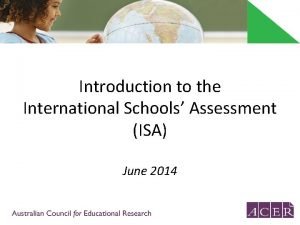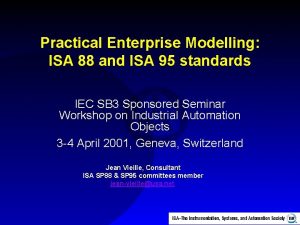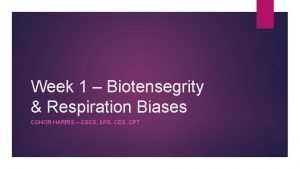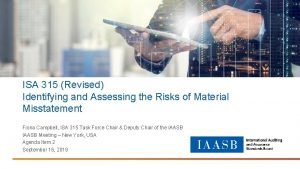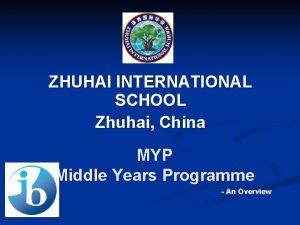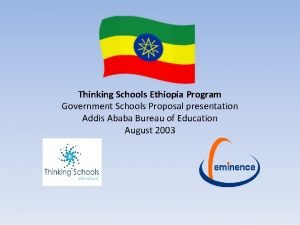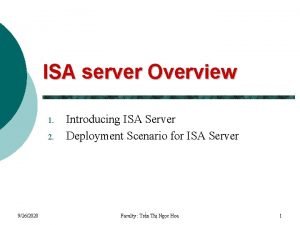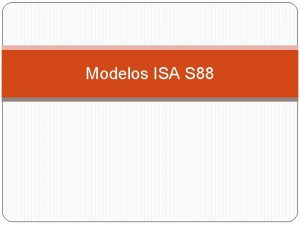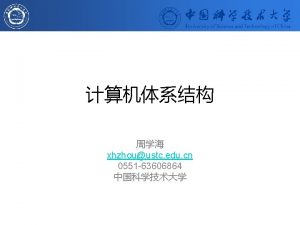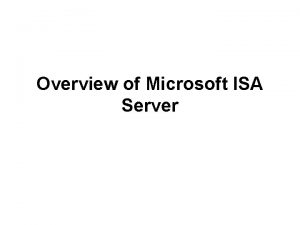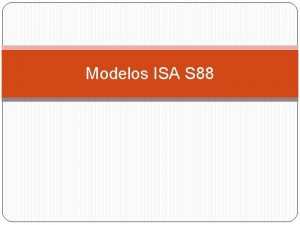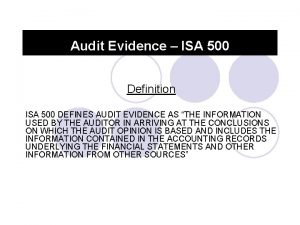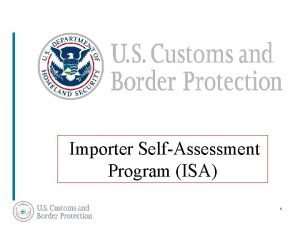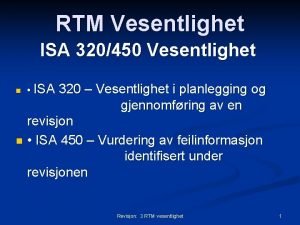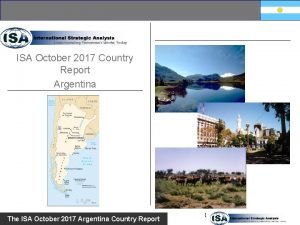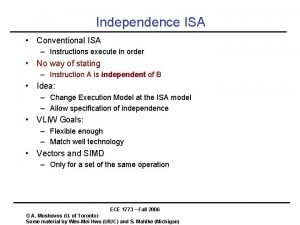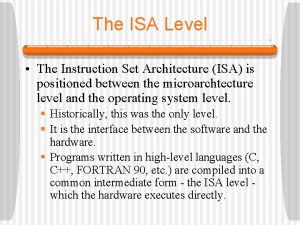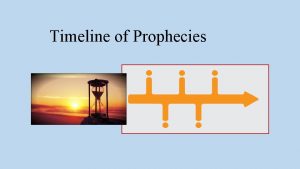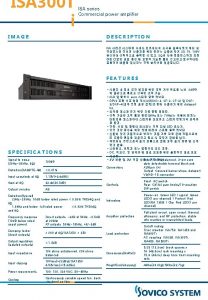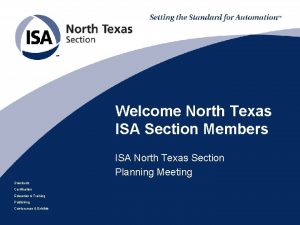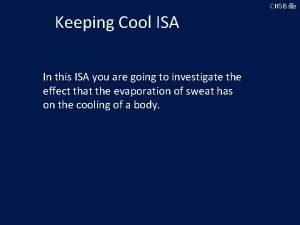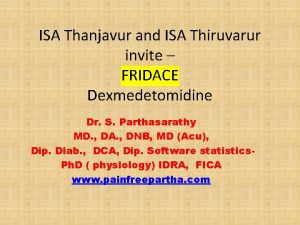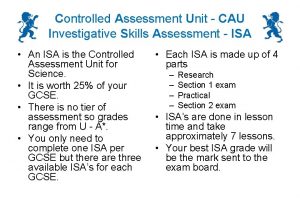Introduction to the International Schools Assessment ISA June





















- Slides: 21

Introduction to the International Schools’ Assessment (ISA) June 2014

Background to the ISA

The ISA is a service of the Australian Council for Educational Research (ACER) ACER’s MISSION About ACER. . . To create and promote research-based knowledge, products and services that can be used to improve learning across the life span. • independent • not-for-profit • 75 years’ experience • more than 300 staff • offices in Australia (Melbourne, Sydney, Brisbane, Perth, Adelaide), India (Delhi) and UAE (Dubai)

ACER and international assessment Consortium leader for the OECD’s Programme for International Student Assessment (PISA) from 1998 – 2012 Member of the International Association for the Evaluation of Educational Achievement (IEA)

What kind of assessment do international schools need? • One that provides reliable evidence for accountability purposes - international benchmarking - feedback to parents and school boards - accreditation reviews • One that provides useful information on which to base curricular and pedagogical decisions - culturally and pedagogically appropriate material for international school populations - reports that describe what students know and can do

Sources for the ISA • Discussions with international schools - ISA trial testing, feedback from curriculum coordinators and teachers, ISA Reference Group Meetings. . . • Programme for International Student Assessment (PISA) - domain frameworks for mathematical literacy, reading literacy and scientific literacy - some common tasks - parallel reporting scale • Assessment design for population testing in Australia and overseas - assessment of children in Grades 3, 5 and 7 - assessment in mathematics (‘numeracy’), reading and writing

Essential Features of the ISA • An assessment of mathematical literacy, reading and writing • For children in international schools at Grades 3 to 10 • Designed on the principle of cultural eclecticism • Mathematical literacy and reading based on the frameworks and scales of OECD PISA

Administration of the ISA • Pencil and paper tests for Mathematical Literacy, Reading and Writing (Grades 3 to 10) • Online assessment of Scientific Literacy (Grades 8 and 10) • Administered by teachers using detailed administration guides • Tasks include multiple-choice, short answer and extended responses • Each test takes 45 minutes to 1 hour (two mornings of testing altogether for pencil and paper tests) - Mathematical literacy (two sessions) - Reading (one session) - Writing (two sessions) -Scientific literacy (one session)

How is the ISA reported?

Features of ISA Reports • A combination of fixed and interactive (MS Excel) reporting services • delivered electronically • for individuals, classes and schools • show progress on a continuum against described proficiency scales • give diagnostic information • allow valid and useful comparisons to be made, for example -with other ‘like’ schools -between cohorts in your school in a given year -between performances of cohorts or individuals over time

Reporting: five standard reports • Individual student report (. pdf) • Class report (. xls &. pdf) • School report (. xls &. pdf) • National comparisons report for Grades 8, 9 &10 only (. pdf) • ISA Interactive diagnostic report (. xlsx) • ISA Interactive tracking report (. xlsx) optional For examples see www. acer. edu. au/tests/isa/sample-reports

National comparisons report Grade 9 compared with national results from PISA 2009 (15 -year-olds)

Detail of National comparisons report Your school’s results National results for PISA participating countries

A profile of ISA Schools

ISA 2013– 14 • Over 70, 000 students • 333 international schools • Number of schools by region: Asia 146 Europe 101 Africa & Middle East 67 Americas 15 Oceania 4

Distribution of ISA participating schools by country 2013– 14

Growth of the ISA, 2002 to 2013– 14

Profile of ISA Schools • School size - modal size 200 -500 students - range from ten schools with fewer than 50 students to one with over 3000 • Over half of schools offer Pre-school to Grade 12 • Only 11 of 333 schools run on southern hemisphere academic calendar • More than one fifth of the schools offer instruction in another language as well as in English

Profile of ISA Schools continued • Curriculum style - Tends to be mixed - More than two thirds use an IB component in their curriculum (178 schools use PYP and/or MYP) - Others predominantly use ‘USA’, then ‘British’ or ‘other national curricula’ or in their description e. g Australian, Indonesian, with or without ‘international’ • More boys than girls in 2013 -14 (between 49% and 55% of each grade level) • At each grade level, almost all students fall within a two-and-a-half year age range

Language Background ISA 2013– 14 English-speaking vs non-English speaking background

For more information Check our website: www. acer. edu. au/isa OR email us: isa@acer. edu. au
 Isa international school assessment
Isa international school assessment Isa-95 levels
Isa-95 levels Infrasternal angle
Infrasternal angle Huntsville city schools powerschool
Huntsville city schools powerschool Safety reach and target schools
Safety reach and target schools Isa 315 summary
Isa 315 summary International schools in zuhai
International schools in zuhai Thinking schools international
Thinking schools international Hình ảnh bộ gõ cơ thể búng tay
Hình ảnh bộ gõ cơ thể búng tay Slidetodoc
Slidetodoc Bổ thể
Bổ thể Tỉ lệ cơ thể trẻ em
Tỉ lệ cơ thể trẻ em Voi kéo gỗ như thế nào
Voi kéo gỗ như thế nào Thang điểm glasgow
Thang điểm glasgow Hát lên người ơi alleluia
Hát lên người ơi alleluia Các môn thể thao bắt đầu bằng từ đua
Các môn thể thao bắt đầu bằng từ đua Thế nào là hệ số cao nhất
Thế nào là hệ số cao nhất Các châu lục và đại dương trên thế giới
Các châu lục và đại dương trên thế giới Cong thức tính động năng
Cong thức tính động năng Trời xanh đây là của chúng ta thể thơ
Trời xanh đây là của chúng ta thể thơ Mật thư tọa độ 5x5
Mật thư tọa độ 5x5 101012 bằng
101012 bằng
